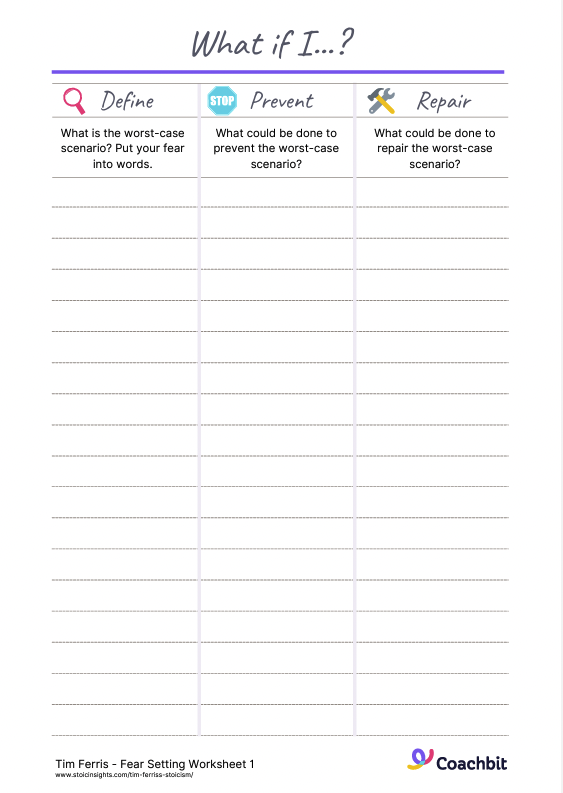
"We suffer more in imagination than in reality." These are the words of Seneca, the Roman stoic philosopher. In Star Wars Episode 3, it seemed that Yoda was on the same bandwagon, "Named must your fear be before banish it you can."
Seneca and Yoda were unknowingly talking about fear-setting - naming and writing down your fears.
Depending on their age, kids face different stresses and fears. Younger children may fear the dark or the 'monster' under their bed, and teenagers may fear failing a test, not getting into their desired college, or being socially rejected. According to Elianna Platt, a licensed social worker, "Being afraid sometimes is a normal, healthy part of growing up."
Fear setting is a helpful and simple tool for kids and teens. It can help them identify their fears and to separate what can be controlled from what cannot.
What is Fear Setting?
Fear setting is when we write down our fears and visualize the worst and best-case scenarios. By doing this, we can plan accordingly and avoid the paralysis that often accompanies fear.
The fear paralysis often leads to inaction, leading to more fear - and the cycle continues.
Instead, focusing on what we CAN control can make our fears more tangible and reduce our stress.
A 2017 study led by Hans Schroder, Assistant Professor in the Department of Psychiatry at the University of Michigan, showed that people who wrote down their worries experienced reduced stress and anxiety compared to those who wrote about topics unrelated to their fears.
Shroder wrote that "writing may serve to 'offload' worries from working memory, relieving the distracting effects of worry on cognition as reflected in a decreased ERN (error-related negativity)."
How Fear Setting Works
Tim Ferris, the author of The 4-Hour Work Week, swears by fear-setting as a "recipe for avoiding self-destruction" and "making better decisions."
Ferris provides a template for fear-setting (found in the recommended resources at the end of this article). The basic structure is outlined below:
First Page
Split the page into three columns.
Column 1: Define -- Write down the worst-case scenario, and describe your fear.
Column 2: Prevent -- Write down what could be done to prevent the worst-case scenario.
Column 3: Repair -- Write down what could be done to repair the worst-case scenario.
Second Page
Write down what the best-case scenario would be. What would happen if you 'did the thing' and it was successful?
Third Page
Write down the cost of inaction if you didn't 'do the thing' -- emotionally, financially, physically? This page can be divided into three columns: cost of inaction in six months, one year, and three years.
**
Fear Setting Template**

Stress Management for Kids
Fear-setting will help children manage their stress and anxiety and teach them to plan better. It will also assist in self-regulation -- allowing them to manage their emotions and behaviors healthily and productively.
As a parent, jumping to 'fix' the situation is tempting when we see our child in distress. It would be more beneficial to encourage them to lean into and listen to their fear or anxiety. By teaching them the principles of fear-setting, we can help them find the words to describe their fears and worries and find the necessary actions to address them.
How to Help Your Kid With Fear-Setting
1. Ask Questions
The fear-setting template can be used for kids but, depending on their age, it is likely that an adult will need to guide them through the process.
For some kids, identifying their fears and anxieties and putting them into words can be difficult.
Asking questions is a great way to gain clarity and help them identify their fears. If they are anxious about giving a presentation at school, the following questions could be helpful to ask:
-What makes you most nervous about the presentation? (the friends watching, fear of public speaking, confusion about the subject)
Do you feel well-prepared for the presentation?
Have you given a presentation before that didn't go how you'd hoped?
2. Fill in the Template
With the greater clarity provided by these questions, your child can go on to complete the first page of the fear-setting template.
What exactly is the 'worst case scenario' -- is it that they will embarrass themselves in front of all their friends or that they will fail?
Once able to properly define the specific fear, action can be chosen to 'prevent' the worst-case scenario.
In this case, is it about setting aside time each day to rehearse the presentation, or is it about revising the work to ensure the presentation notes are accurate -- or both?
Finally, should the presentation go horribly and the fear becomes a reality, what can be done to 'repair' the situation -- for example, ask the teacher for feedback for future presentations and set up a time with a teacher or tutor to go over the work.
Validate Their Fears
Expressing fears and emotions is difficult for many children, and for most it does not come easy. A parent or caretaker should take these fears seriously. 'Wow! It sounds like you are scared. That noise was loud."
After offering validation and comfort, it is important to move swiftly on and start talking about how fear can be managed and what action can be taken. According to Dr. Busman, we shouldn't spend too much time "offering comfort around the scary thing because even that can become reinforcing and take on a life of its own."
Final Thoughts
Patience and encouragement are both essential when guiding your child through fear. The process of fear-setting will most likely be uncomfortable for them at first, and they may even be resistant. To recap, fear-setting follows these simple steps:
1. Define the fear and worst-case scenario.
2. Consider what could be done to prevent it from happening.
3. Consider what could be done to repair the situation if it happens.
4. Consider the best-case scenario.
5. Consider the cost of inaction.
During periods of stress such as exams, college admissions, or sports tryouts, fear-setting can be highly beneficial and relieve the symptoms of stress both mentally and physically, allowing us to spend greater energy on what matters -- preparation.
Sources:
Schroder HS, Moran TP, Moser JS. The effect of expressive writing on the error-related negativity among individuals with chronic worry. Psychophysiology. 2018 Feb;55(2):
How many core habits and skills is your child missing?
Take our short quiz and find out.
Take our quiz

_Z2dC98e.webp)
